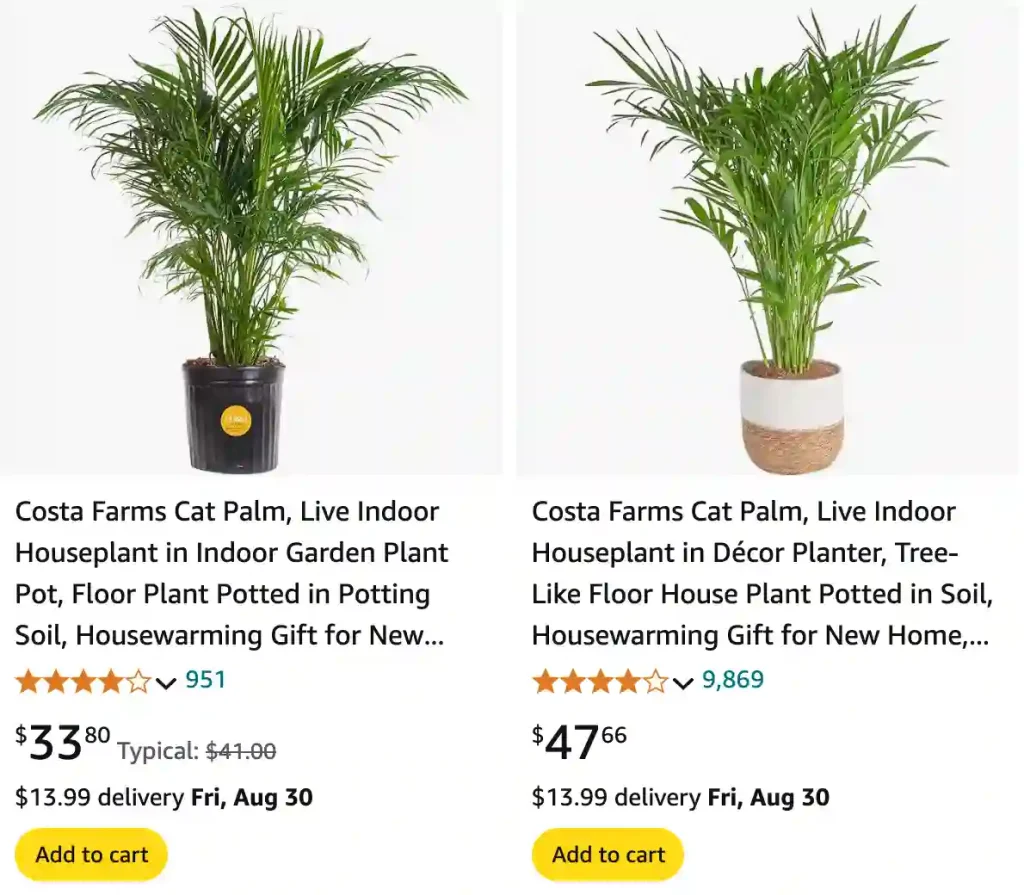
Frequently Asked Questions About Cat Palm
Cat Palms are among my favorite indoor plants. They bring a touch of the tropics into any space and have a lush, green appearance that I find incredibly calming. Over the years, I’ve received quite a few questions about Cat Palms. So, I thought I’d address some of the most common ones here.
106 Species in Genus Chamaedorea
What Is a Cat Palm?
The Cat Palm (Chamaedorea Cataractarum) is a small palm species known for its dense, feathery fronds. Native to southern Mexico and Central America, this plant is a popular choice for indoor gardening due to its manageable size and lush appearance. Cat Palms typically grow to about 3-6 feet tall, making them an excellent choice for homes and offices. Their fronds are deep green, and the plant has a bushy appearance, which adds a tropical vibe to any room.
How to Care for a Cat Palm?
Caring for a Cat Palm is relatively straightforward, but there are a few things to keep in mind to ensure your plant stays healthy. Cat Palms thrive in well-draining soil and prefer a spot that receives bright, indirect light. Overexposure to direct sunlight can cause the leaves to burn, while too little light can lead to poor growth. Maintaining a consistent watering schedule is crucial—Cat Palms like their soil to be consistently moist but not soggy.
How Often to Water Cat Palm?
Watering a Cat Palm can be a bit tricky since it prefers moist soil. I usually water my Cat Palm when the top inch of the soil feels dry to the touch. During the warmer months, you might need to water more frequently, about once a week. In the cooler months, the watering frequency can be reduced. Remember, it’s important not to let the soil dry out completely but also avoid waterlogging, as that can lead to root rot.
Does Cat Palm Need Sunlight?
Yes, Cat Palms need sunlight, but they prefer bright, indirect light. Direct sunlight can scorch their delicate fronds, while low light conditions can stunt their growth. If you’re keeping a Cat Palm indoors, placing it near a window with filtered light is ideal. For outdoor placements, a shaded spot that receives dappled sunlight works well.
Is Cat Palm Safe for Cats?
One of the biggest concerns for pet owners is whether a plant is safe for their furry friends. I’m happy to say that Cat Palms are safe for cats. According to the ASPCA, Cat Palms are non-toxic to cats, making them a great choice for households with feline companions. You can enjoy the lush greenery without worrying about your cat’s health.
Is Cat Palm Safe for Dogs?
Just like with cats, Cat Palms are also safe for dogs. They are non-toxic and won’t harm your canine friends if they happen to nibble on the fronds. This makes Cat Palms an excellent choice for pet-friendly homes.
Why Is My Cat Palm Turning Yellow?
Yellowing leaves on a Cat Palm can be a sign of several issues. It could be due to overwatering, underwatering, or nutrient deficiencies. If your Cat Palm is turning yellow, first check the soil moisture. If the soil is too wet, reduce the watering frequency. If it’s too dry, increase the watering schedule. Additionally, Cat Palms can benefit from a balanced, water-soluble fertilizer during the growing season to ensure they get the necessary nutrients.
Is Cat Palm Indoor or Outdoor?
Cat Palms are versatile and can be grown both indoors and outdoors. Indoors, they make beautiful houseplants, adding a touch of greenery to any room. Outdoors, they thrive in shaded areas, such as under larger trees or on shaded patios. However, in colder climates, Cat Palms are best kept indoors, as they prefer temperatures above 50°F.
Cat Palm vs. Majesty Palm
Cat Palm and Majesty Palm (Ravenea rivularis) are often confused, but they have some differences. Majesty Palms are taller and have a more tree-like appearance, whereas Cat Palms are bushier and more compact. Majesty Palms also require more light and humidity, making them slightly more challenging to care for indoors compared to Cat Palms.
Cat Palm vs. Areca Palm
Areca Palms (Dypsis lutescens) are similar in appearance to Cat Palms but tend to grow taller and have more arching fronds. Areca Palms also prefer bright, indirect light and can handle more direct sun than Cat Palms. Both are great indoor palms, but Areca Palms may need more space due to their larger size.
Cat Palm vs. Parlor Palm
Parlor Palms (Chamaedorea elegans) are another popular indoor palm variety. They are smaller and more delicate-looking than Cat Palms, making them ideal for tabletops or smaller spaces. Parlor Palms require similar care to Cat Palms but are more tolerant of lower light conditions, making them easier to grow in rooms with less natural light.
Cat Palm vs. Bamboo Palm
Bamboo Palms (Chamaedorea seifrizii) have a similar appearance to Cat Palms but are taller and have thinner fronds. They also grow in clumps, resembling bamboo stalks, hence the name. Bamboo Palms are well-suited for indoor environments and share the same care requirements as Cat Palms, thriving in bright, indirect light.
Cat Palm vs. Kentia Palm
Kentia Palms (Howea forsteriana) are known for their elegance and tall, slender fronds. They are more robust and can grow taller than Cat Palms, making them a statement piece in larger spaces. Kentia Palms are also more forgiving of lower light conditions and require less humidity than Cat Palms, making them easier to care for indoors.
In conclusion, Cat Palms are a beautiful and relatively easy-to-care-for option for both indoor and outdoor gardening. They are safe for pets, prefer bright, indirect light, and require consistent watering. Whether you are looking to add a touch of greenery to your home or compare them to other popular palms, Cat Palms are a versatile and attractive choice.
If i die, water my plants!



